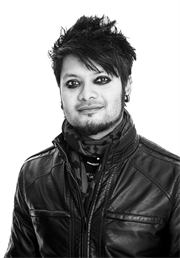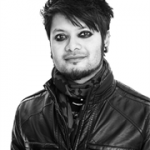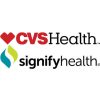MedicalDeviceSummit introduces MEDdesign – a new column/ e-newsletter that will focus on medical device design topics and trends. Exciting topics such as ”Future of integrated healthcare; Power of ergonomics within design, Biomimicry: Design innovation inspired by nature; Visualizing the BIG picture; Material selection and Designing for special populations, will be covered by expert writers from Carbon Design Group; Design Design; Ergonomidesign; Farm; Ximedica and Rob Lichty, a biomimicry professional.
Specific topics that you want to see covered here? Write to me at SViswanathan@InnovativePublishing.net, or just use the comment feature at the end of the article.
The future of Health Care is a subject that has aroused intense speculation recently. Predicting possible futures for the health care industry is an ambitious task, fraught with great risk. There are far too many disparities in global health care systems and the industry is constantly affected by Government legislation, making the rate of development impossible to predict on through one uniform solution. Having said that, I will try to guide you into a possible future through a fictive scenario that includes both already existing technology and technologies under development in labs around the world.
Health care in an age of ubiquitous computing
The scenario, spinning around the two friends Bernhard and Hannah, is set in a world where embedded sensors and microprocessors are gathering data about us in real-time. This data is stored in the Cloud (a metaphor often used to describe the future Internet). In a few years, desktop computers as we know them today will probably be relics of the past. Rapid advances in screen technology and the diminishing size of microprocessors will make it possible to invent new archetypes for the computer, coupled with new gestural and semantic languages. Our walls, tables and other elements in our environment may become platforms to interact on.
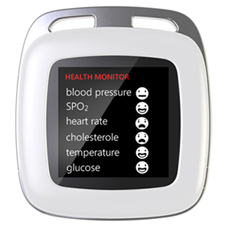
Our protagonist Bernhard is a 48-year-old banker from New York. Bernhard’s reckless approach to life had almost resulted in disaster a few years ago. He developed acute coronary arterial disease (CAD). Doctors warned him that if the condition was left untreated it would result in devastating consequences. Fearing a stroke, Bernhard has now taken control of his health using the latest services and products. These solutions are available to him by a Healthcare Service Provider (HSP). By using a ‘CAD-treatment app’ in the course of his daily routine, Bernhard prevents his illness from slipping out of control. Guided by his doctor, he takes charge of his own health and monitors his data efficiently with a personalized device, the miniME.
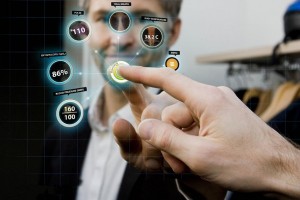
biometric data
What is a medical treatment app?
In a few years, HSPs will be strategic evolutions of what they are known as today. We envision HSPs as mergers of hospitals, pharmacies and professional medical networks. Most HSPs will also merge with Internet service providers allowing HSPs easier access to the benefits of the Cloud. The ‘CAD treatment app’, that Bernhard uses, is a typical medical-service, downloadable from the “Health Care app store”. Bernhard’s doctor prescribes the app that is downloaded to a personalised device, in this case called ‘miniME’*. Bernhard goes to the pharmacy to get his miniME updated with the prescribed software.

care app-store
Much like in the mobile ‘app-world’, patients in the future are using personalised medical devices containing embedded software (apps), which synchronises with relevant sensors on our body. miniME connects biometric sensors placed on the body to track health stats using RFID (Radio Frequency Identification) and NFC (Near Field Communication). The tiny device measures ECG, blood pressure, heart rate, pulse oximetry, body temperature, blood glucose, cholesterol and haemoglobin.
miniME forwards Bernhard’s biometric data in real-time to the Cloud, offering Bernhard’s HCP’s and peers constant access to the information. The communication with networks can be via mobile devices, other specialist medical devices and smart surfaces.
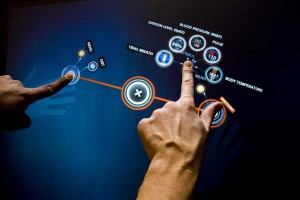
to compare biodata
Bernhard’s CAD treatment app keeps him in constant reach of his directory of doctors, fellow patients, medical prescriptions and other programs such as diet and exercise. The volume of stored data about Bernhard turns out to be invaluable to an old acquaintance of his – Hannah.
Health, information and recovery at your fingertips
We now zoom in on one serendipitous interaction at a dinner at Bernhard’s place with Hannah, one of the guests.
Hannah is a 51 year old journalist living in Paris. She has a demanding position at her company which involves a relentless amount of travel including long hours of sitting still and rich, fatty food. Hannah has always thought of herself as a healthy person and to stay healthy despite her stressful life, she takes care of herself by using a “General Health app.” The service guides her toward a healthier lifestyle in terms of food habits, nutritional advice, a personal training, advice on vitamins and so on.
Recently Hannah had sensed that something is wrong with her. Over a conversation, Hannah and Bernhard decide to compare biometric data on Bernhard’s smart table. Exploring the connection interface, Hannah discovered that her biometric data, matched those of Bernhard’s data five years ago when he was diagnosed with CAD. She is alarmed at first.
However, since this crucial information about her impending CAD problem found its way to her at an early stage, it gives Hannah precious time to act and prevent the condition. By sharing knowledge and contacts with Bernhard, Hannah quick-starts her treatment by contacting Bernhard’s cardiac specialist doctor right away.
As soon as the next day Hannah is able to go to her nearest located pharmacy to update her miniME with the prescribed CAD app that will measure relevant data specified by her new doctor. In this way Hannah’s doctor is able to start her treatment precious days before what is possible in our world of today, since her data have been collected long before their appointment.
Just as doctors today prescribe pills and ointments to treat our symptoms, future HCPs would collaborate with software developers, bio and nanotech experts to also prescribe the right kinds of software to monitor and treat us.
Why are scenarios and props like these useful for the design of medical experiences? Henry Ford had once famously said – ‘If I had asked my users what they wanted, they would have asked for a faster horse’. Genius inventions like the automobile are borne of future vision – aspirations and ambitions beyond the limitations and boundaries of the present.
We believe stories like the one told in this article help us to suspend disbelief momentarily and imagine possible future worlds. In order to design for better future worlds, we need to imagine them. Dream them. This is what this article aims to achieve.
Thank you.
Rahul

